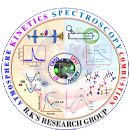The rate coefficient for the gas-phase reaction of Cl atoms with p-cymene was determined as a function of temperature (288–350 K) and pressure (700–800 Torr) using the relative rate technique, with 1,3-butadiene and ethylene as reference compounds. Cl atoms were generated by UV photolysis of oxalyl chloride ((COCl)2) at 254 nm, and nitrogen was used as the diluent gas. The rate coefficient for the reaction of Cl atoms with p-cymene at 298 K was measured to be (2.58 ± 1.55) × 10–10 cm3 molecule–1 s–1. The kinetic data obtained over the temperature range 288–350 K were used to derive an Arrhenius expression: k(T) = (9.36 ± 2.90) × 10–10 exp[−(488 ± 98)/T] cm3 molecule–1 s–1. Theoretical kinetic calculations were also performed for the title reaction using canonical variational transition state theory (CVT) with small curvature tunneling (SCT) between 250 and 400 K. The calculated rate coefficients obtained over the temperature range 250–400 K were used to derive an Arrhenius expression: k(T) = 5.41 × 10–13 exp[1837/T] cm3 molecule–1 s–1. Theoretical study indicated that addition channels contribute maximum to the total reaction and H-abstraction channels can be neglected. The atmospheric lifetime (τ) of p-cymene due to its reactions with various tropospheric oxidants was estimated, and it was concluded that the reactions of p-cymene with Cl atoms may compete with OH radicals in the marine boundary layer and in coastal urban areas where the concentration of Cl atoms is high.
-
Call
-
E-mail
Journal Details
1. Experimental and computational investigation on the gas phase reaction of p-cymene with Cl atoms..
M. R. Dash, G. Srinivasulu, B. Rajakumar. Phys. Chem. , , 559-570., 119, 4
